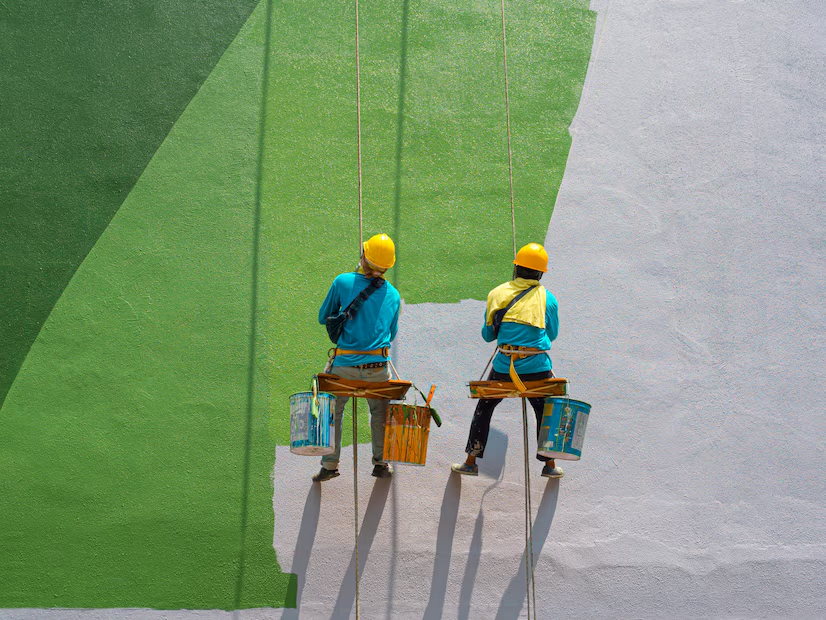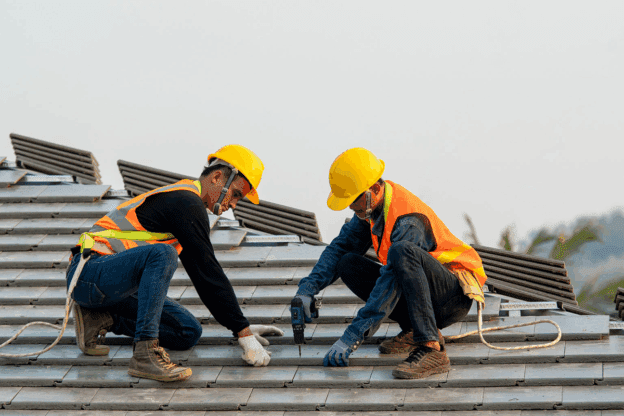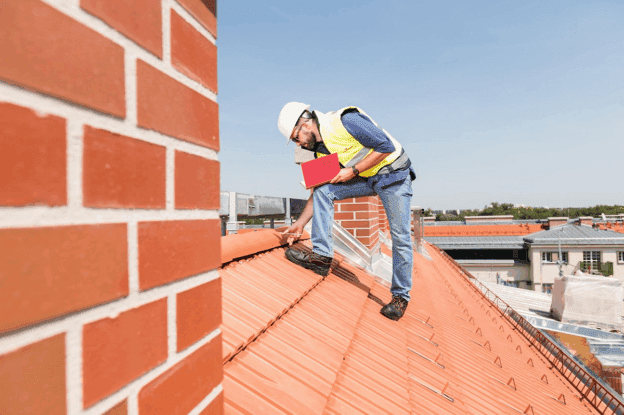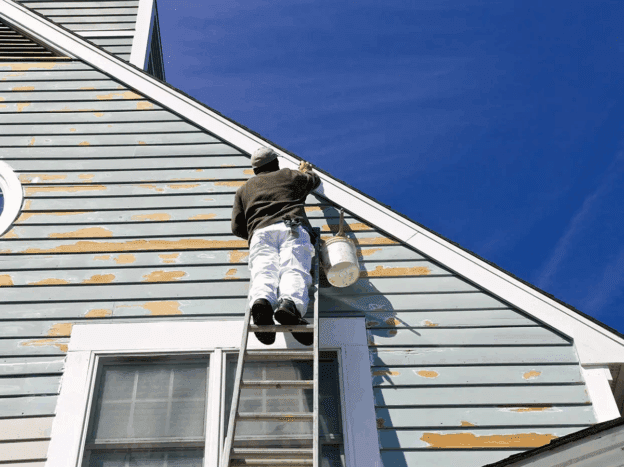
Essential Tips for a Successful Exterior Painting Project
When it comes to sprucing up a home, exterior painting stands out as one of the most impactful ways to enhance curb appeal. Yet, achieving a flawless finish isn’t just about picking the right color. It involves a mix of preparation, technique, and understanding the elements that can affect the final result.
From choosing the right type of paint to knowing when to tackle your project, several key factors play a role in ensuring the job is done right. Dive into these insights to transform the exterior with ease and confidence.
Importance of Proper Surface Preparation
Proper surface preparation is critical for a successful exterior painting project. Taking the time to thoroughly prepare ensures that the paint adheres well and lasts longer, providing a smooth and durable finish.
- Cleaning the Surface: Remove dirt, grime, and old paint with a pressure washer or scrubbing tools. This ensures that the new paint will adhere properly and evenly.
- Repairing Damage: Fill in cracks and holes with suitable fillers. Addressing surface imperfections prevents future peeling and ensures a smooth, flawless finish.
- Sanding the Surface: Sanding removes rough patches and old paint remnants, creating a smooth surface for better paint adhesion and a more even final look.
- Applying Primer: Use a primer to seal the surface and improve paint adhesion. Primer helps create a consistent base and can block stains or previous paint colors.
- Protecting Surroundings: Use drop cloths and painter’s tape to protect areas not being painted. This prevents accidental splatters and ensures clean, sharp edges.
By ensuring proper surface preparation, the longevity and appearance of the paint job are greatly enhanced, leading to a more professional and enduring result.
How Weather Conditions Impact Your Project
Weather conditions play a significant role in the success of an exterior painting project. Ideal painting weather is mild, with temperatures ranging between 10°C and 30°C. Painting in extreme heat or cold can affect how the paint dries and adheres. High humidity can cause paint to dry too slowly, leading to runs and drips, while very dry conditions can make the paint dry too quickly, resulting in uneven coverage.
Rain is another major factor; painting just before a rainstorm can lead to poor adhesion and streaks. It’s also wise to avoid painting in direct sunlight, as it can cause the paint to dry too fast and impair its ability to properly set.
Choosing the Right Tools for the Job
Selecting the right tools for exterior painting is crucial for achieving a professional-looking finish. Brushes, rollers, and sprayers each have their strengths and are suited to different aspects of the project. For detailed work and trim, a high-quality brush is ideal for precision and control.
Rollers are excellent for covering large, flat surfaces quickly and evenly, but it’s important to choose the correct nap length based on the texture of the surface being painted. Sprayers can be beneficial for a smooth, even coat on large areas but require careful handling to avoid overspray and ensure even coverage.
Essential Techniques for a Smooth Finish
Achieving a smooth finish in exterior painting requires mastering several essential techniques. Implementing these methods can make a significant difference in the final appearance and longevity of the paint job.
- Apply Thin Coats: Use thin, even coats of paint instead of one thick layer. This approach reduces the risk of drips and streaks, ensuring a more uniform finish. Allow each coat to dry completely before applying the next to achieve the best results.
- Maintain a Wet Edge: Keep a wet edge by working in sections and blending each new section with the previously painted area. This technique helps to avoid visible lines and ensures a seamless, consistent finish throughout the surface.
- Use Proper Brush and Roller Techniques: When using a brush or roller, apply paint in a consistent pattern, such as W or M shapes. This method helps achieve even coverage and prevents roller marks or brush strokes from showing.
- Sand Between Coats: Lightly sand the surface between coats to remove any imperfections and ensure smooth adhesion of the next layer. This step helps in achieving a polished look and can improve the paint’s durability.
- Protect Surrounding Areas: Use drop cloths and painter’s tape to protect areas not being painted. This precaution prevents accidental spills and drips, maintaining clean lines and ensuring a professional finish.
By following these techniques, the quality and longevity of the exterior painting project will be greatly enhanced, resulting in a smooth and professional appearance.
Key Factors in Paint Colour Selection
Selecting the right color is one of the most significant decisions in exterior painting and can greatly influence the home’s overall appearance and curb appeal. Consider the architectural style of your home and the surrounding environment when choosing a color. Neutral colors often complement a variety of styles and can make your home appear larger, while bold colors can create a striking effect.
It’s also useful to test paint samples on a small area of the exterior to see how they look in different lighting. Finally, ensure that the chosen color complies with any local regulations or homeowners’ association guidelines. Making an informed choice will ensure the color enhances the home’s aesthetic and fits harmoniously with its surroundings.
Understanding Different Paint Finishes and Types
The type of paint finish can greatly affect the appearance and durability of an exterior painting job. Paints come in several finishes, including matte, satin, semi-gloss, and gloss. Matte finishes are excellent for hiding imperfections but can be less durable and harder to clean. Satin finishes offer a soft sheen and are more washable, making them a good choice for high-traffic areas.
Semi-gloss and gloss finishes are highly reflective and durable, which makes them ideal for trim, doors, and other high-impact areas. In addition to finishes, paint types vary in terms of formulation and performance. Acrylic paints are popular for their versatility and resistance to weathering, while oil-based paints offer durability and a smooth finish but can take longer to dry. Understanding these options helps in selecting the best paint to meet specific needs and achieve the desired look.
Timing Your Project for Optimal Results
Timing can greatly influence the outcome of an exterior painting project. Choosing the right time of year is essential for ensuring optimal paint application and longevity. Spring and autumn are often the best seasons for exterior painting due to mild temperatures and lower humidity levels. Painting during these times reduces the risk of issues related to extreme weather conditions.
It’s also crucial to plan the project around the paint’s drying time and the weather forecast. Avoid scheduling painting tasks during periods of high humidity or imminent rain, as these can interfere with the paint’s drying process and overall finish. Proper timing helps achieve a flawless finish and ensures that the paint adheres well and lasts longer.
Ensuring Longevity with Quality Primer Application
Using a quality primer is a key step in ensuring the longevity and durability of an exterior painting project. Primer serves multiple purposes: it seals the surface, enhances paint adhesion, and provides a uniform base for the topcoat. A good primer can also help cover stains and block moisture, which prevents problems like peeling and blistering. It’s particularly important to apply primer on new or repaired surfaces, as it helps create a stable foundation for the paint.
Choose a primer that matches the type of paint being used, whether oil-based or water-based, to ensure compatibility. Applying primer correctly—using even strokes and allowing it to dry completely before painting—sets the stage for a more successful and long-lasting paint job. Investing time in this preparatory step will pay off with a smoother finish and greater paint durability.
Common Mistakes to Avoid During Painting
When it comes to exterior painting, avoiding common mistakes can significantly impact the final result. Here are some key pitfalls to watch out for:
- Skipping Surface Preparation: Failing to clean, sand, or repair the surface can lead to poor paint adhesion and a less durable finish. Proper preparation ensures the paint bonds well and lasts longer.
- Using Incorrect Paint Type: Different surfaces require specific types of paint. Using the wrong formula can affect the appearance and longevity of the paint job. Always match the paint to the surface and conditions.
- Improper Application Techniques: Applying paint too thickly or using incorrect methods can result in dribs and uneven coverage. Use thin, even coats and maintain a wet edge for a smooth finish.
- Ignoring Weather Conditions: Painting in extreme temperatures or high humidity can affect the drying and curing of the paint. Aim for mild conditions to ensure optimal results and avoid weather-related issues.
- Neglecting Drying Times: Rushing through the project without allowing adequate drying time between coats can lead to poor results. Follow the manufacturer’s recommendations for drying times to ensure a successful finish.
Avoiding these mistakes will help achieve a professional-looking and long-lasting paint job.
Successfully tackling an exterior painting project requires careful planning and attention to detail. From selecting the right paint and tools to understanding the impact of weather and proper surface preparation, each step is crucial for achieving a durable and visually appealing finish. Avoiding common mistakes and applying essential techniques ensures that the paint job not only looks great but lasts longer.
Ready to transform your home’s exterior with a professional touch? For expert advice and high-quality results, reach out to Tidal Remodeling. Contact Tidal Remodeling at +1 (760) 990-7890 to schedule a consultation and get started on your next project. Let’s bring new life to your home’s exterior together.



